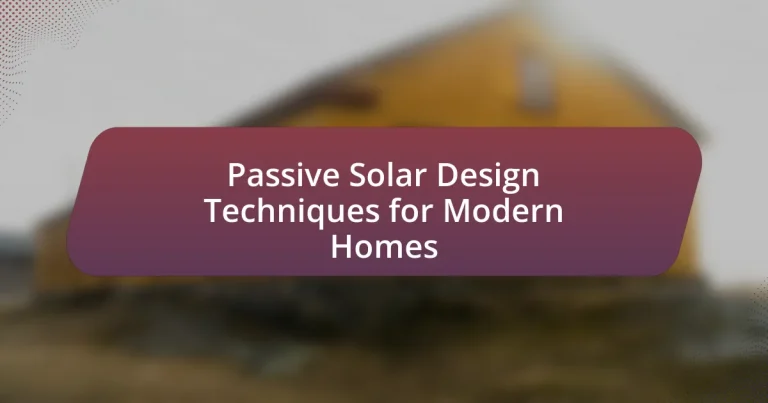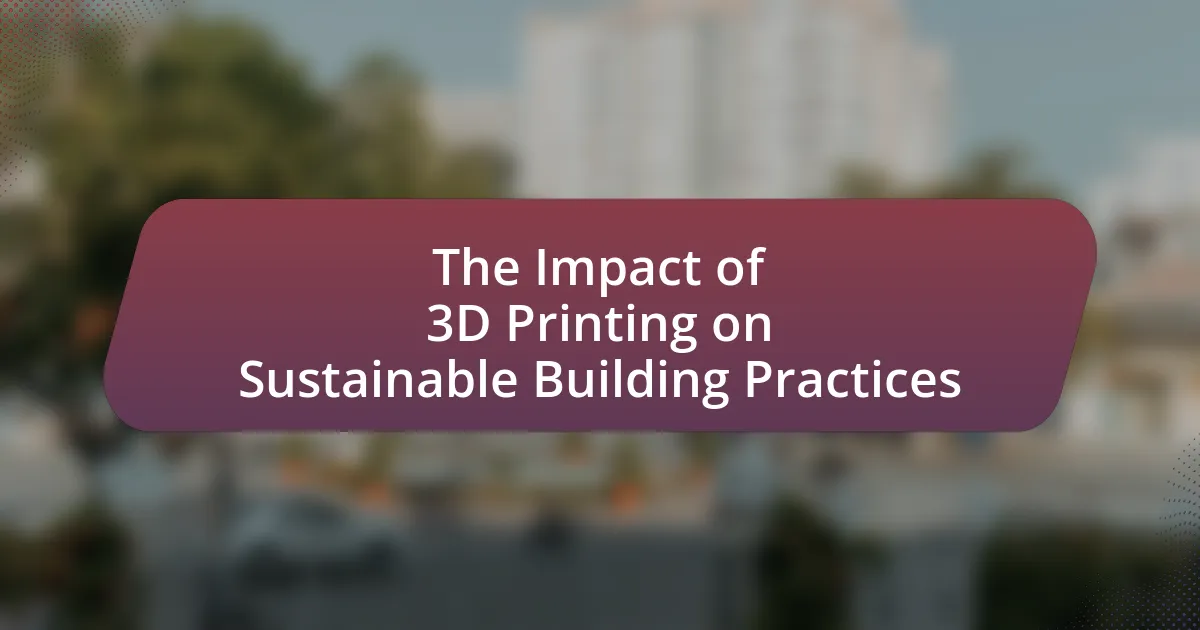Passive solar design techniques for modern homes focus on utilizing natural sunlight to enhance indoor comfort and reduce energy consumption. Key strategies include optimal window placement, the use of thermal mass materials, and effective insulation to regulate temperatures throughout the year. These techniques can lead to significant energy savings, improved air quality, and a reduced carbon footprint. The article explores the principles of passive solar design, the impact of orientation and layout, and practical tips for homeowners to implement these strategies effectively, ultimately promoting sustainability in residential architecture.

What are Passive Solar Design Techniques for Modern Homes?
Passive solar design techniques for modern homes include strategies that utilize natural energy from the sun to maintain comfortable indoor temperatures and reduce energy consumption. Key techniques involve strategic placement of windows for optimal sunlight exposure, using thermal mass materials like concrete or stone to absorb and store heat, and incorporating overhangs or awnings to control solar gain during different seasons. These methods can significantly decrease reliance on artificial heating and cooling systems, leading to lower energy bills and a reduced carbon footprint. For instance, homes designed with south-facing windows can capture maximum sunlight in winter while minimizing heat gain in summer, demonstrating the effectiveness of these techniques in enhancing energy efficiency.
How do Passive Solar Design Techniques work in modern architecture?
Passive solar design techniques work in modern architecture by utilizing natural energy from the sun to maintain comfortable indoor temperatures and reduce reliance on mechanical heating and cooling systems. These techniques include strategic placement of windows for optimal sunlight exposure, thermal mass materials that absorb and store heat, and proper insulation to minimize heat loss. For instance, buildings designed with south-facing windows can capture maximum sunlight during winter, while overhangs can provide shade in summer, effectively regulating indoor temperatures throughout the year. Studies show that homes employing passive solar design can achieve energy savings of 30% to 50% compared to conventional designs, demonstrating their effectiveness in enhancing energy efficiency and sustainability in modern architecture.
What are the key principles of passive solar design?
The key principles of passive solar design include orientation, thermal mass, insulation, and window placement. Orientation involves positioning a building to maximize sunlight exposure, particularly on the south side in the Northern Hemisphere, which can enhance natural heating. Thermal mass refers to materials that absorb and store heat, such as concrete or stone, which help regulate indoor temperatures by releasing stored heat when needed. Insulation is crucial for minimizing heat loss during colder months and reducing heat gain in warmer months, ensuring energy efficiency. Finally, strategic window placement and sizing allow for optimal daylighting and ventilation, contributing to overall comfort and energy savings. These principles collectively enhance a building’s energy efficiency and reduce reliance on mechanical heating and cooling systems.
How do orientation and layout influence passive solar effectiveness?
Orientation and layout significantly influence passive solar effectiveness by determining how much sunlight a building receives throughout the day. Proper orientation, typically aligning the longest side of a building to face south in the Northern Hemisphere, maximizes solar gain during winter while minimizing it during summer. For instance, a study by the U.S. Department of Energy indicates that buildings oriented correctly can achieve up to 30% more solar heat gain in winter months compared to poorly oriented structures. Additionally, layout affects the placement of windows, overhangs, and thermal mass, which can enhance or hinder the building’s ability to store and distribute solar energy effectively. Therefore, thoughtful orientation and layout are crucial for optimizing passive solar design in modern homes.
What are the benefits of implementing Passive Solar Design Techniques?
Implementing Passive Solar Design Techniques offers significant benefits, including reduced energy consumption and enhanced indoor comfort. These techniques utilize natural energy sources, such as sunlight, to maintain comfortable temperatures in buildings without relying heavily on mechanical heating or cooling systems. For instance, studies show that homes designed with passive solar principles can achieve energy savings of 30% to 50% compared to conventional designs. Additionally, passive solar design can improve air quality and reduce greenhouse gas emissions, contributing to a more sustainable environment.
How do these techniques contribute to energy efficiency?
Passive solar design techniques contribute to energy efficiency by optimizing natural energy sources, such as sunlight, to reduce reliance on mechanical heating and cooling systems. These techniques include strategic placement of windows, thermal mass materials, and overhangs that maximize solar gain in winter while minimizing it in summer. For instance, homes designed with south-facing windows can capture sunlight during colder months, leading to a reduction in heating costs by up to 30% according to the U.S. Department of Energy. Additionally, the use of thermal mass, such as concrete or stone, helps store heat during the day and release it at night, further enhancing energy efficiency.
What impact do they have on indoor comfort and air quality?
Passive solar design techniques significantly enhance indoor comfort and air quality by optimizing natural light and temperature regulation. These techniques, such as strategic window placement and thermal mass utilization, allow for improved daylighting and reduced reliance on artificial heating and cooling systems. Research indicates that homes designed with passive solar principles can maintain comfortable temperatures year-round, leading to a reduction in energy consumption by up to 50%. Additionally, better air quality is achieved through increased ventilation and reduced humidity levels, which are essential for preventing mold growth and ensuring a healthier living environment.

What are the different types of Passive Solar Design Techniques?
The different types of passive solar design techniques include direct gain, indirect gain, and isolated gain. Direct gain involves the use of large south-facing windows to capture sunlight, which heats the interior space directly. Indirect gain utilizes thermal mass, such as walls or floors, to absorb and store solar energy, releasing it gradually. Isolated gain refers to sunspaces or solariums that collect solar energy but are separated from the main living area, allowing for controlled heat transfer. These techniques enhance energy efficiency and reduce reliance on mechanical heating systems, contributing to sustainable building practices.
How does thermal mass play a role in passive solar design?
Thermal mass plays a crucial role in passive solar design by absorbing, storing, and releasing heat, which helps to regulate indoor temperatures. Materials with high thermal mass, such as concrete, brick, or stone, can absorb excess heat during the day and release it at night, thereby reducing the need for mechanical heating and cooling systems. This characteristic enhances energy efficiency and comfort in buildings, as evidenced by studies showing that homes designed with adequate thermal mass can maintain stable temperatures with minimal energy input.
What materials are commonly used for thermal mass?
Common materials used for thermal mass include concrete, brick, stone, and adobe. These materials are effective because they have high specific heat capacity, allowing them to absorb, store, and release heat efficiently. For instance, concrete can store significant amounts of heat due to its density and thermal conductivity, making it a popular choice in passive solar design. Similarly, brick and stone also provide substantial thermal mass, contributing to temperature regulation in buildings.
How does thermal mass affect temperature regulation in homes?
Thermal mass significantly enhances temperature regulation in homes by absorbing, storing, and releasing heat. Materials with high thermal mass, such as concrete, brick, and stone, can stabilize indoor temperatures by absorbing excess heat during the day and releasing it at night, thereby reducing temperature fluctuations. Studies indicate that homes designed with adequate thermal mass can maintain comfortable temperatures with less reliance on heating and cooling systems, leading to energy savings and improved comfort levels. For example, a study by the U.S. Department of Energy found that buildings with high thermal mass can reduce energy consumption by up to 30% compared to those without.
What is the significance of window placement and sizing?
Window placement and sizing are crucial in passive solar design as they directly influence natural light, heat gain, and energy efficiency in modern homes. Properly positioned windows can maximize solar exposure during winter while minimizing it in summer, thus enhancing thermal comfort and reducing reliance on artificial heating and cooling systems. Research indicates that strategic window placement can lead to energy savings of up to 30% in residential buildings by optimizing daylighting and reducing the need for electric lighting. Additionally, the size of windows affects the amount of solar heat gain; larger windows can capture more sunlight, but they must be balanced with shading techniques to prevent overheating.
How do window types and glazing affect solar gain?
Window types and glazing significantly influence solar gain by determining how much solar radiation enters a building. Different window types, such as single-pane, double-pane, and triple-pane, have varying thermal performance, with double and triple-pane windows typically offering better insulation and reduced heat loss. Glazing options, including low-emissivity (Low-E) coatings, can reflect infrared light while allowing visible light to pass through, thereby enhancing solar gain in winter while minimizing it in summer. For instance, Low-E glass can reduce heat transfer by up to 50%, making it a popular choice in passive solar design. The combination of window type and glazing directly affects energy efficiency, comfort, and heating costs in modern homes.
What strategies can optimize natural light while minimizing heat loss?
To optimize natural light while minimizing heat loss, implementing strategies such as using high-performance glazing, strategically placing windows, and incorporating thermal mass is essential. High-performance glazing, which includes low-emissivity (Low-E) coatings, reduces heat transfer while allowing ample sunlight to enter, thus maintaining indoor warmth without excessive energy loss. Strategically placing windows on the south side of a building maximizes sunlight exposure during winter months, while overhangs can block high summer sun, reducing heat gain. Additionally, incorporating thermal mass materials, like concrete or stone, can absorb heat during the day and release it at night, further stabilizing indoor temperatures. These strategies collectively enhance natural light utilization and minimize heat loss, contributing to energy-efficient passive solar design.

How can homeowners effectively implement Passive Solar Design Techniques?
Homeowners can effectively implement Passive Solar Design Techniques by strategically positioning windows, utilizing thermal mass materials, and incorporating overhangs or shading devices. Positioning windows to face south maximizes sunlight exposure during winter while minimizing it in summer, which can reduce heating and cooling costs by up to 30%. Using materials like concrete or brick for thermal mass helps store heat during the day and release it at night, enhancing indoor comfort. Additionally, overhangs can block high summer sun while allowing lower winter sun to enter, optimizing natural light and temperature regulation. These methods collectively contribute to energy efficiency and comfort in modern homes.
What are the best practices for integrating passive solar design in new builds?
The best practices for integrating passive solar design in new builds include optimizing building orientation, utilizing thermal mass, incorporating appropriate window placement and sizing, and ensuring adequate insulation. Optimizing building orientation involves positioning the structure to maximize solar gain during winter while minimizing it during summer, typically by aligning the longest side of the building to face south in the Northern Hemisphere. Utilizing thermal mass, such as concrete or stone, helps store heat during the day and release it at night, stabilizing indoor temperatures. Appropriate window placement and sizing enhance natural light and heat gain; larger windows should be placed on the south side, while smaller windows on the north side reduce heat loss. Adequate insulation in walls, roofs, and floors minimizes heat transfer, maintaining comfortable indoor temperatures year-round. These practices are supported by studies indicating that passive solar design can reduce energy consumption by up to 50% in residential buildings.
How can existing homes be retrofitted for passive solar benefits?
Existing homes can be retrofitted for passive solar benefits by enhancing their thermal mass, improving insulation, and optimizing window placement. Enhancing thermal mass involves adding materials like concrete or stone that absorb and store heat during the day and release it at night, which stabilizes indoor temperatures. Improving insulation in walls, roofs, and floors reduces heat loss in winter and heat gain in summer, making the home more energy-efficient. Optimizing window placement includes installing larger south-facing windows to maximize solar gain while minimizing openings on the north side to reduce heat loss. These strategies collectively improve energy efficiency and comfort in existing homes, aligning with passive solar design principles.
What common mistakes should be avoided in passive solar design?
Common mistakes to avoid in passive solar design include inadequate orientation of windows, poor thermal mass selection, and neglecting shading strategies. Inadequate orientation of windows can lead to insufficient solar gain during winter months, reducing energy efficiency. Poor thermal mass selection may result in ineffective heat retention or release, failing to stabilize indoor temperatures. Neglecting shading strategies can cause overheating in summer, undermining the benefits of passive solar design. These mistakes can significantly diminish the effectiveness of a passive solar system, leading to increased energy costs and discomfort in living spaces.
What resources are available for homeowners interested in passive solar design?
Homeowners interested in passive solar design can access a variety of resources, including online guides, local workshops, and professional consultations. Websites such as the U.S. Department of Energy provide comprehensive information on passive solar techniques, including design principles and case studies. Additionally, organizations like the American Solar Energy Society offer educational materials and events focused on solar energy and sustainable building practices. Local building departments may also provide resources and regulations specific to passive solar design in their areas, ensuring compliance with local codes.
How can professional consultations enhance passive solar design outcomes?
Professional consultations can significantly enhance passive solar design outcomes by providing expert insights that optimize energy efficiency and comfort. Professionals, such as architects and energy consultants, assess site conditions, climate, and building orientation to recommend tailored strategies that maximize solar gain and minimize heat loss. For instance, studies show that homes designed with professional input can achieve up to 30% greater energy efficiency compared to those designed without expert guidance. This is due to their ability to integrate advanced modeling tools and techniques, ensuring that design elements like window placement, thermal mass, and shading devices are effectively utilized.
What online tools and software can assist in planning passive solar homes?
Online tools and software that assist in planning passive solar homes include SketchUp, EnergyPlus, and SolarCalc. SketchUp is a 3D modeling tool that allows users to design and visualize building layouts, including solar orientation and shading analysis. EnergyPlus is a comprehensive energy simulation program that models heating, cooling, lighting, and other energy flows in buildings, providing insights into energy efficiency and solar gain. SolarCalc is a specialized tool for calculating solar angles and potential solar energy production based on geographic location and building orientation. These tools are widely used in the architecture and engineering fields to optimize passive solar design, ensuring effective energy use and sustainability in modern homes.
What practical tips can homeowners follow to maximize passive solar design benefits?
Homeowners can maximize passive solar design benefits by strategically positioning windows and using thermal mass materials. Properly oriented south-facing windows can capture sunlight during winter while minimizing heat gain in summer. Incorporating materials like concrete or brick, which retain heat, enhances energy efficiency by releasing stored warmth during cooler periods. Additionally, using overhangs or awnings can block high summer sun while allowing lower winter sun to enter, optimizing natural heating and cooling. These strategies collectively improve comfort and reduce energy costs, demonstrating the effectiveness of passive solar design in modern homes.





